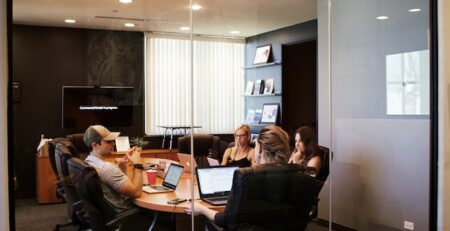New Talent in the Workplace: How Can You Accommodate Them So They Can Thrive?
When the search is over, and your company finally has the perfect candidate hired and onboarded into a position, how do you keep them happy to make sure they stay? More importantly, rather than trying to keep them in one place, what’s the best way to facilitate their growth so that they can move up in the ranks?
These questions have to do with employee retention strategies, which simply stated are efforts to promote a good work environment so that employees continue working with the company. Most of the time, employee retention has to do with things that interest talent across the board. That might be improved work-life balance through remote work from home opportunities, robust benefits packages, the chance to learn and grow, cutting edge technology and strategies, or an open and communicative workplace.
A sense of purpose and meaningful work are two of the central driving factors for happy workers, and they go further to retain talent than just about anything else. Creating that sense of fulfillment in employees derived from making a positive impact on the world can be challenging, but with enough imagination, it’s one of the best ways to improve things for all the workers at once. Take care to create a good work environment so everyone from the temp web designer to the head of sales feels fulfilled in their work.
Hopefully, you saved time and money by finding your talent through a creative staffing agency like icreatives. If that’s the case, then there are some additional ways you can improve your employee retention rates. If you didn’t use a creative staffing agency to find your talent, it’s never too late to bring us in so we can help boost your retention rates with strategies like insourcing or promoting from within.
Companies would do well to split employee desires as immediate and long-term. A sense of purpose is long-term, but the desire for more sunlight or cleaner air in the office is immediate. If management seems to only focus on one or the other, their efforts to make the employees’ situation better will lose credibility and might appear unserious altogether.
Employee retention and strategies will vary with each business and likely from person to person. The following strategies work to help discover what your company can deliver for employees and how to give them a sense of purpose so they can rise to meet their potential.
A Closer Look at Employee Retention Strategies
There’s no way to keep the turnover rate at zero for sure, but there are many ways to reduce the likelihood that employees will want to leave. The key is to look at things as objectively as possible and then reconsider them from the employees’ point of view. The business has specific goals, but management and the top brass would do well to remember that meeting them depends on the hard work of the entire staff.
Salary and benefits are undoubtedly the driving factors candidates consider when they’re choosing between jobs. Still, many other things motivate them to stay once they’re part of the team. Successful employee retention strategies don’t focus on one employee complaint or desire at a time. Instead, to be effective, these strategies should consider the entire office and all of its constituent parts and make changes that will shift things toward the positive on the macro level.

Onboarding New Talent – Starting on the Right Foot
Employees can become dissatisfied at any point in their time at a company, but giving them the right first impression, and training will go a long way toward keeping them happy. Training and onboarding should give them a realistic idea about working for the company. It’s not so much that their expectations should be lower, but that giving them an honest depiction will also communicate that you and others are well aware of how things are. That indicates that there is a clear line of communication from the lowest temp web designer to the top, and management listens to employees.
Remember that orientation is also the perfect time to describe the company, its mission, its current trajectory, and, most importantly, where and how their particular role there fits into the bigger picture. That will help foster a sense of purpose for the employee. This idea should be explicit and clear enough to stay on their mind as they continue working. Returning to the mission statement made in these initial meetings and noting benchmarks or altering goals will give a sense of progress and a job well done.
Addressing Immediate Concerns
Things that will make working life for employees easier in the day to day course of their job are frequently the simplest things to fix, but ignoring them can impact management’s credibility quickly. Here are a few things around the office that might be negatively impacting employees’ impressions of the company:
- Natural Light & Clean Air
It’s not realistic to think you can cut a window out of the wall next to every single desk, but finding office space with plenty of natural light coming in helps keep people awake and energized throughout the day. If there’s no light, or the light is entirely artificial, workers may start to feel like they’re stuck in a cave. Plus, working without windows tends to skew the perception of time and make the day seem much longer. Fresh air or at least regularly circulated air will also give employees more energy and allow them to concentrate better.
- Temperature & Noise
Similarly to having natural light and clean air, being able to sit comfortably at a desk without sweating or shivering means employees will stay at their desks longer and therefore accomplish more tasks. Finding a happy medium is difficult, especially in the transition seasons. But the important thing is to have a strong enough cooling and heating system to keep the temperature stable in any weather. Noise makes concentrating and working on the phone difficult. It’s a bit complicated to keep a call center quiet so the people can hear each other on the phone, but don’t rule out noise ordinances so people can complete their work.
- Cutting-Edge Technology
Creatives and other workers who have a genuine passion for their work want to be working with the most current tools and strategies. Even a temp web designer won’t want to be using software from ten years ago on a computer from twenty years ago. Long-term employees are always looking for a way to expand their skillset and part of that means working with the latest and greatest technology. Tech is an immediate need when it comes to the office copier, drink machines, and key cards, but there are other ways that having updated hardware and software can help give employees a sense of purpose and keep retention up long-term.
- Work-Life Balance
Just like the technology question, ensuring employees can have an even work-life balance is something that can be implemented in the short-term and will have positive effects on retention in the long run. Employees want enough time to live their lives and not feel stuck at the office. Giving them plenty of options for remote work from home or remote working a few days a week helps break up the routine. Working parents, particularly, cite work flexibility and remote working possibilities as being the most critical factor in their workplace satisfaction, second only to work-life balance.
Common Mistakes with Immediate Concerns
Most of these things can be fixed immediately or in the short-term. Many companies go about it the wrong way, though. When employees want clean air and natural light, for example, giving them access to both only during certain hours of the day is not going to cut it. Maybe having sunlight on your lunch break is better than not having any at all, but it won’t impact energy levels as much as it will if there is always natural light and fresh air.
When addressing problems with the office itself, buying a new building or even retrofitting the existing one won’t be feasible all the time. It’s much more practical to address these concerns by organizing the space you have smartly. This will require thinking of the office as a whole and allowing employees to express their needs and wants so that everyone can be made comfortable.
Technology is another place where companies make mistakes. Yes, employees want to be on the cutting edge, but that means with their professional tools. Buying everyone including the temp web designer company iPhones instead of addressing software issues or upgrading the printer, for example, is bound to disappoint and be a waste of money in the end.
Work-life balance is by far the most common money pit for companies trying to boost retention. Rather than surveying or listening to employees to find out what can to do to make them happy, companies too often build flashy things like attached gyms, nap rooms, or put ping pong tables and a soda fountain in the break room. These types of solutions might sound like fun, but in reality, they’re more likely to appeal to a small percentage of workers and look wasteful to the rest. Many would prefer remote work from home opportunities to a gym any day.
Long-Term Employee Retention Strategies
Keeping talent happy and comfortable will help them stay productive and promote a good work environment, but it doesn’t do anything to address the most significant concern for 21st-century employees: a sense of purpose.
Giving employees the sense that they are having a positive impact on society or helping in the larger goal of the company are some of the leading reasons people stay in jobs long-term. Without that, the job is all about the money, and that means the employee can be snapped up by the first company that can afford to pay them a higher salary or offer better benefits.
One of the best strategies for long-term employee retention is called insourcing, and creative staffing agencies are the cheapest and easiest ways for companies to begin. At icreatives, we have a long history of helping companies successfully bring outsourced duties back in-house and that’s given us a variety of tactics to ensure it’s a success at your business.
If you want to promote a good work environment, giving employees a sense of purpose is the best way. Here are a few strategies that can help:
- Open Communication with Leadership
Too many companies drive a wedge between the top brass and the rest of the employees. Whether that’s intentional or not, it doesn’t bode well for the general atmosphere. It also prevents employees from communicating things that frustrate them or they find lacking about working there. If there’s no outlet, those employees will jump ship when they find a company that will listen. Employees should be able to request remote work from home and leave suggestions for management without repercussions.
Leadership should also communicate with employees. Not only to check in on them but also to detail company goals and give updates on implementation. If employees do a good job, let them know. Tell them what was successful and what that means for the company. They probably don’t want to hear about how much money it made the company if they’re not going to get a bonus for it, but explaining how it furthered the goals of the company will help them contextualize their personal impact.
- Create Clear Career Paths
Even if you’re only hiring a temp web designer, giving them a clear idea of what their job duties entail will help them meet or even exceed expectations. The same goes for full-time talent. Not only do they want to know what their job duties are, but they’ll also benefit from understanding how that fits in with the other roles at the company. Nobody wants to feel like they’re filing paperwork or completing projects and then shipping them off. If you want to give employees a sense of purpose, demonstrate how their work fits into the broader business process.
This will also give them the opportunity to understand what kind of opportunities await them if they stick around at the company. Workers who have any ambition at all might not stay on very long if there’s no place for them to advance. But if they know the ins and outs of their entire department and the company itself, they might spearhead the creation of new duties for themselves. Not only will they be happy and stick around, but the company can benefit from their innovation.
- Corporate Responsibility: The Triple Bottom Line
One model that can help managers and decision-makers demonstrate the social impact of their company is called the triple bottom line. Rather than only concentrating on the traditional bottom line, which is the net profit or loss of the business, the Triple Bottom Line blends social, economic, and environmental effects. How your company chooses to make a social impact will vary with your location and what’s happening in the world. As an example, recycling programs that are spearheaded by employees can lead to a sense of accomplishment and community in the workplace.
Participating in social equity or Fair Trade initiatives is one way to improve the social footprint of a business. Working with local charities or schools is another way. Monitoring resource consumption and innovating the way the company disposes of its waste products will help improve the environmental aspect. When measuring the economic impact of the company, don’t just show how much profit it took in, but also add in social benefits in the area or positive impacts on connected places. All of this will work together to give employees a sense of purpose and keep them happy.

Conclusion:
Bringing the best talent is only the beginning of the battle. As high-skilled talent has become rarer in recent decades, competition for talent has escalated between companies. While it’s still not a jobseeker’s market, employees are looking for benefits like a good work environment, remote work from home opportunities, and a sense of purpose in their work.
The best employee retention strategies look at employees as a whole but also leave space for development and communication for individual workers. Understanding how changes for employees will have impacts across all the individuals that make up the workforce is essential to implementing the right strategies.
For more information about how insourcing works as a successful employee retention strategy, contact icreatives today!












